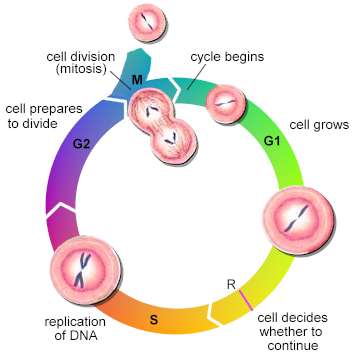The art of medicine consists in amusing the patient while nature cures the disease. Voltaire (1694 - 1778)
31 January 2012
The Cell Cycle Clock and Cancer
The cell cycle clock represents a normal cell life in four main stages.
Stage 1 Gap 1 (G1): the cell increases in size, and prepares to copy the DNA contained in its nucleus.
Stage 2 Synthesis (S): the chromosomes of the cell are replicated
Stage 3 Gap 2 (G2): the cell prepares for mitosis
Stage 4 Mitosis (M): the mother cell divides into two daughter cells, each containing a complete set of chromosomes. The two daughter cells immediately enter the G1 stage to continue the cycle.
Restriction point (R): a molecular switch which determines whether the cell continues the cell cycle, enters the G0 state (senescence) or undergoes apoptosis - programmed cell death. There are two classes of genes that play a major role in triggering cancer. Cells in the human body can only survive when their 'area code' where the cell is compatible with the code of the surrounding cells and the extra-cellular matrix. Therefore, normal cells die by apoptosis if they try to leave their cell structure. This is known as anchorage dependence. Proteins produced by oncogenes in cancer cells trick the nucleus by making it seem that the cell is attached to the correct region, while it is actually not. This allows cancer calls to migrate freely throughout the human body via the blood circulation system
